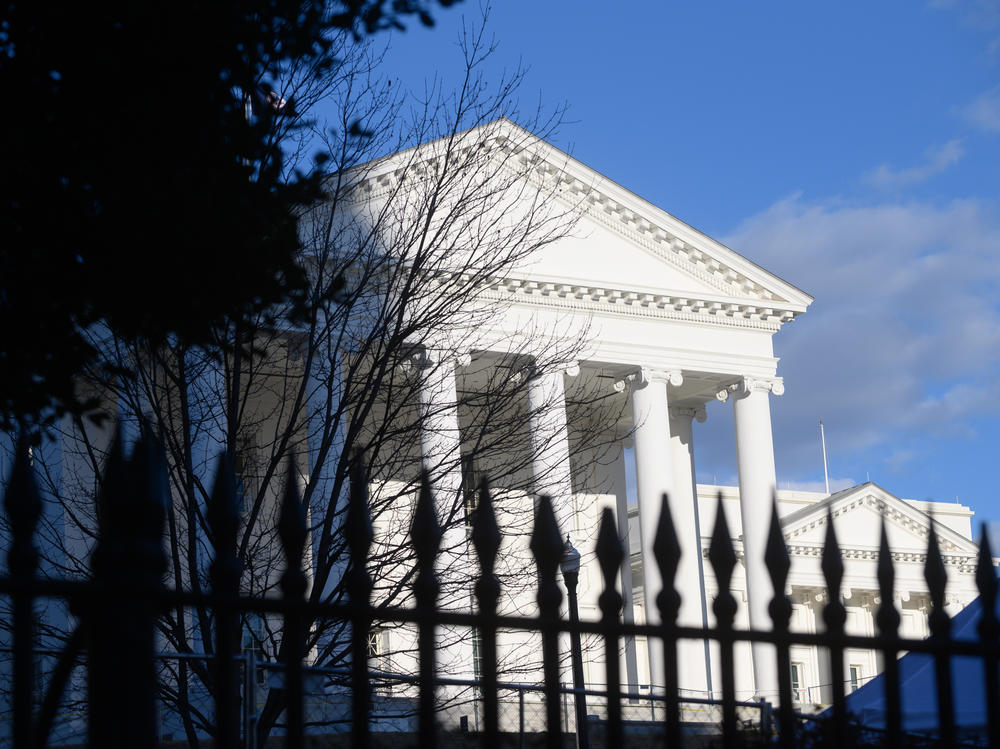Section Branding
Header Content
Confederate Figures Removed From Virginia Capitol In The Dead Of Night
Primary Content
A 900-pound bronze statue of Gen. Robert E. Lee has stood on the same spot at the Virginia state Capitol where the Confederate leader took command of the Army of Northern Virginia in 1861.
On Friday morning, that statue of Lee clad in a Confederate uniform was gone. So were the busts of seven other Confederates that had occupied places of honor in Virginia's Old House Chamber for decades, including those of Confederate President Jefferson Davis and Confederate Gen. Thomas "Stonewall" Jackson.
The statuary and a plaque honoring Confederate House Speaker Thomas Bocock were quietly removed from the Capitol overnight on orders from the current Virginia House of Delegates speaker, Democrat Eileen Filler-Corn.
"Virginia has a story to tell that extends far beyond glorifying the Confederacy and its participants," Filler-Corn, the Virginia Legislature's first female speaker, said in a statement. "The Confederacy's primary objective in the Civil War was to preserve an ideology that maintained the enslavement of human beings. Now is the time to provide context to our Capitol to truly tell the Commonwealth's whole history."
Citing authority granted her by the Virginia Constitution and House of Delegates rules, Filler-Corn directed that chamber's clerk to remove the Confederate figures. Her office said the operation was "supervised by a professional conservator to ensure their appropriate movement."
The statuary was taken to an undisclosed location, according to the Richmond Times-Dispatch. A spokesman for Filler-Corn told the newspaper that she "had decided on an unannounced, overnight removal to avoid the presence of protesters, who might threaten the safety of the removal process."
The stealth action won plaudits from Delegate Lamont Bagby, chairman of the Virginia Legislative Black Caucus. He dismissed the removed items as "misguided symbols that honored a lost cause" that should be "relegated to a space outside of the people's Capitol."
"Generations of Virginians, Americans, and visitors from around the world have been greeted by these imposing symbols of treason and white supremacy for far too long," Bagby said in a statement. "If we are going to continue building a more inclusive and just Commonwealth, we must acknowledge and denounce the darkest parts of our nation's history, not celebrate them."
But a Republican member of Virginia's state Senate condemned the Confederate monuments' overnight eviction.
"Under the cloak of darkness our spineless governor takes down Virginia's historical landmarks within the people's capital," Sen. Amanda Chase wrote on her Facebook page, mistakenly identifying Virginia Democratic Gov. Ralph Northam as having removed the Confederate figures.
Northam's plans to remove a statue of Lee on Richmond's Monument Avenue are currently facing a court challenge.
Other Confederate leaders whose likenesses were removed from the Capitol include Gen. "Jeb" Stuart, Confederate navy Cmdr. Matthew Fontaine Maury, Gen. Joseph Eggleston Johnston, Confederate Vice President Alexander Stephens and former Virginia Gov. Fitzhugh Lee. Most of the busts were installed in an era ranging from the Great Depression through the early 1950s.
Harry Byrd, the former Virginia governor who fiercely opposed the racial integration of the commonwealth's public schools in the 1950s, helped lead the push in 1928 to erect a statue in the former capital of the Confederacy honoring Lee.
It's not clear what will happen to the banished Confederate statuary now. Filler-Corn announced she has formed an advisory group to determine what should be done with the objects as well as to consider the erection of "additional historic artifacts and historic context" in areas of the Capitol controlled by the House of Delegates.
"The artifacts at the Capitol are a painful reminder of the deep-rooted wounds of slavery and 401 years of oppression," said Delores McQuinn, a Democratic delegate from Richmond who will chair the speaker's advisory group. "These Confederate artifacts are constant reminders of individuals who had no intentions of guaranteeing justice, equality and equity for all."
Copyright 2020 NPR. To see more, visit https://www.npr.org.

